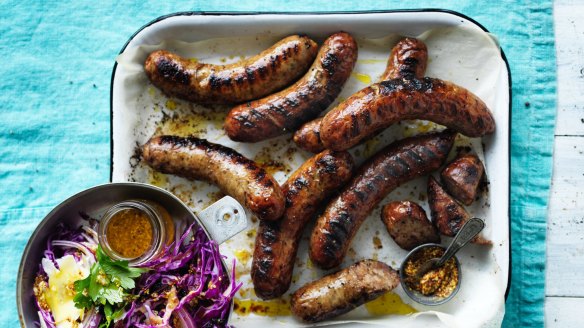How do I stop sausages from splitting on the barbecue?

My sausages always split. W. Johns
I remember my father making raging fires in the brick fireplace in the backyard. Impatient or just wanting to feed the hungry family, the sausages and chops would go on the red hot steel plate. The chops ended up burnt, and the sausages disgorged their innards onto the barbecue. Sausages are encased in animal gut, or extruded collagen, that is very thin. Fierce heat will expand the innards of a snorker too quickly, causing the skin – rendered brittle by the heat – to fail. A such, sausages require low, slow heat to cook the interior and allow the skin to brown and caramelise. Take your time.
When I coat my food in flour or breadcrumbs, I always have too much coating leftover. F. Briggs
Add a few tablespoons of flour or crumbs to a freezer bag, along with seasoning. Add a few portions of the food you're flouring or crumbing. Give the bag a shake and remove the food. If you need more flour or crumbs to complete the job, add more. Simple.
When a recipe asks for fortified wine, such as port or muscat, can I use red wine? E. Bedin
Australia's fortified wines are national treasures. I was lucky enough to witness the muscat vintage in Rutherglen earlier this year. Small brownish grapes are allowed to ripen with some of them drying on the vine to become almost raisin-like. Super sweet and packed with the most delicious flavour, the grapes are crushed, fermented, and almost pure alcohol is added, bringing fermentation to a sudden halt, leaving a sweet, intensely flavoured wine that is then aged in oak. To make muscat, the winemakers blend wines from different barrels, some a few years old, others dating to sometime last century. To keep those wines aging silently in those vast cellars is a massive investment by those dedicated winemakers and the reason Australia produces some of the best fortified wines on the planet. Those wines contain a lot of natural sugar, about 100g per litre, compared with a dry red wine, which has about 2g of residual or unfermented sugar. If a recipe calls for port, muscat or a sweet sherry such as pedro ximenez, the final dish will have a sweetness about it, along with those aged and fermented notes. You could use red wine, but you won't get the required sweetness. You could use apple juice, which has about the same sugar content as fermented wine, or a mixture of apple juice, wine, and reduced stock to help replicate the mouthfeel. But you can pick up a bottle of exceptional Australian fortified wine for less than $25, worth drinking long after the cooking is over. Because we signed trade deals with Europe, we can't call it port anymore, so look for "vintage fortified", "ruby fortified" or "tawny fortified". As far as Tokay goes, the Australian wine industry decided to call it "topaque", an ugly word that not even modern parents would name a child. But it's delicious nonetheless. And if you're looking for the local answer to sherry, it's now labelled apera.
My containers of stock won't fit in my freezer. P. Van
Strain your (unsalted) stock and reduce its volume by slowly cooking it down, evaporating the liquid off. The stock will thicken and become quite concentrated. Cool and pour this into self-sealing sandwich bags and freeze them flat, and your stock will then take up about as much space as a Penguin classic. To use, defrost and dilute it with water if you wish.
Send your vexing culinary conundrums to brainfood@richardcornish.com.au or tweet to @foodcornish
Appears in these collections
- More:
- Food
- Brain food
